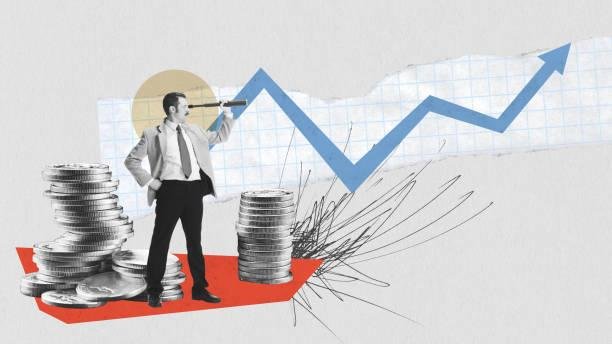-
Feed de notícias
- EXPLORAR
-
Blogs
Micro-Investing: How Small Amounts Add Up Big

Micro-investing is a modern, accessible way to start investing using small amounts of money—often just a few dollars at a time. Traditionally, investing was viewed as something only for the wealthy or financially savvy. People believed you needed hundreds or even thousands of dollars to get started. Micro-investing changes that perception by allowing anyone to participate in the market, regardless of their income level.
Thanks to digital platforms and mobile apps, micro-investing makes it possible to invest your spare change, round up everyday purchases, or set up recurring deposits as low as $1. The barriers are lower than ever, and the process is simple enough for beginners to understand and manage.
Why Micro-Investing Matters Today
In today’s economy, many people struggle with saving or believe they don't earn enough to invest. Micro-investing empowers individuals—especially young adults and new investors—to build financial habits and grow wealth gradually. It offers a way to participate in the financial markets without needing a large lump sum or extensive financial knowledge.
More importantly, micro-investing democratizes access to wealth-building tools. With just a smartphone and a few dollars, almost anyone can become an investor. This matters because the earlier someone starts investing, the more time they have to benefit from compound growth—even if they’re starting with very small amounts.
The Power of Compounding Over Time
One of the biggest advantages of micro-investing is the ability to harness the power of compounding. When you invest, your money earns returns. Over time, those returns start earning returns as well. This cycle of growth multiplies your money significantly if you give it enough time.
Even small contributions can add up big if you start early and stay consistent. For example, investing just $5 a day at an average return of 7% annually could grow to over $70,000 in 20 years. That’s the magic of compounding—small steps lead to big outcomes when combined with time and discipline.
Micro-investing doesn’t require perfect timing or large sums. It requires consistency, patience, and a willingness to let time work in your favor.
How Micro-Investing Apps Work
Micro-investing platforms have revolutionized how people interact with their finances. Apps like Acorns, Stash, and Robinhood offer user-friendly experiences tailored to small investments. Most allow you to link your bank account, set up automatic contributions, and invest your spare change by rounding up transactions.
These apps often invest your money in diversified portfolios made up of low-cost index funds or ETFs (Exchange-Traded Funds). Some platforms also offer educational resources to help beginners learn as they go. The focus is on automation, simplicity, and low-cost entry—making investing part of your everyday life, not a separate financial task.
Micro-investing apps are designed to remove friction and reduce excuses. If you've ever felt that investing was too complicated or that you didn’t have enough money to start, these platforms prove otherwise.
Building Good Financial Habits
One of the greatest benefits of micro-investing is that it encourages positive financial behavior. By automating small contributions, you build the habit of saving and investing without having to think about it constantly. These habits become part of your routine and set the foundation for better financial decisions later.
Even if the amounts are small, the act of consistently setting money aside creates discipline. It teaches you to live on slightly less, plan for the future, and stay committed to long-term goals. Financial success rarely comes from one big move—it’s usually the result of many small, consistent actions over time.
Micro-investing creates a sense of progress, which builds confidence. You begin to see your balance grow, understand how markets work, and feel more comfortable increasing your contributions over time.
Micro-Investing vs. Traditional Investing
Micro-investing isn’t a replacement for traditional investing—but it’s a fantastic entry point. Once you’re comfortable with micro-investing, you can transition to more structured investment strategies, such as retirement accounts, real estate, or building a diversified stock portfolio.
The main difference is in the scale and frequency. Traditional investing often involves larger contributions, long-term planning, and more active portfolio management. Micro-investing is more casual, passive, and designed to get you started. Both approaches can work together: micro-investing helps you build the habit, and traditional investing helps you grow wealth more aggressively as your income increases.
For beginners, starting small is often better than not starting at all. Micro-investing helps break through the inertia and removes the fear that many people associate with investing.
Who Should Consider Micro-Investing?
Micro-investing is ideal for anyone who feels overwhelmed by traditional investing, has limited disposable income, or is just beginning their financial journey. Students, young professionals, gig workers, and even retirees looking to build better money habits can all benefit from micro-investing platforms.
It’s also perfect for people who procrastinate on big financial goals because they feel unattainable. Instead of waiting until you can save $1,000 or more, micro-investing lets you begin with what you have today. That momentum often leads to greater engagement with your finances and the confidence to take on bigger goals later.
Managing Expectations with Micro-Investing
While micro-investing is a powerful tool, it’s important to manage expectations. You won’t become wealthy overnight, and the growth might seem slow in the beginning. But like watering a plant, consistent care and time yield results.
Also, fees on some micro-investing apps can eat into your returns if your balance stays very low for a long time. Be sure to choose a platform with transparent, reasonable fees—ideally ones that don’t charge more than your investments can realistically earn over time.
Micro-investing is a starting point, not the finish line. It’s a bridge between saving and serious investing, and it works best when paired with learning and growing your financial knowledge along the way.
The First Step Is the Most Important
Accoridng to FJP Solutions The biggest barrier to investing for most people isn’t money—it’s mindset. Micro-investing removes the fear and uncertainty that hold people back and offers a simple, risk-managed way to take that all-important first step.
Once you start, you’ll discover how easy it is to build a foundation for your financial future. Whether you're saving for retirement, a vacation, or financial freedom, micro-investing is proof that small actions, done consistently, can lead to life-changing results.
You don’t need thousands of dollars to be an investor. You just need a plan, a little commitment, and a willingness to start where you are.





